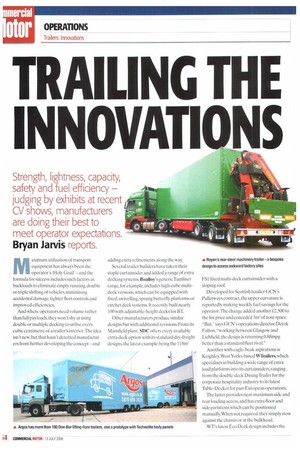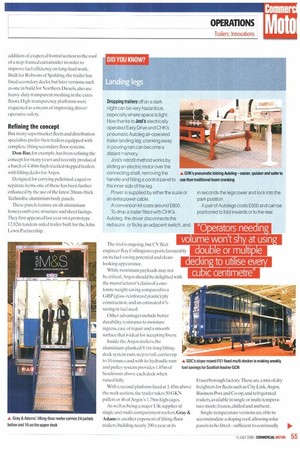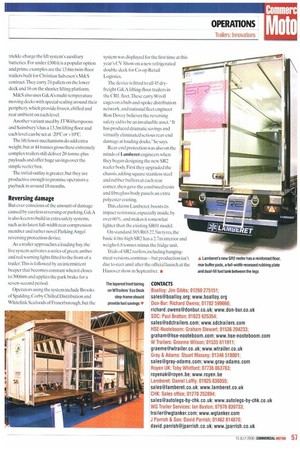TRAILING THE NNOVATI
Page 54

Page 55

Page 57

If you've noticed an error in this article please click here to report it so we can fix it.
Strength, lightness, capacity, safety and fuel efficiency — judging by exhibits at recent CV shows, manufacturers are doing their best to meet operator expectations.
Bryan Jarvis reports.
Maximu in utilisation of transport equipment has always been the operator's 'Holy Grail — and the formula for success includes such factors as backloads to eliminate empty running, double or triple shifting of vehicles, minimising accidental damage, tighter fleet controls and improved efficiencies.
And where operators need volume rather than full payloads, they won't shy at using double or multiple decking to utilise every cubic centimetre of a trailer's interior.The idea isn't new, but that hasn't deterred manufacturers from further developing the concept —and adding extra refinements along the way.
Several trailer builders have taken their staple curtainsider and added a range of extra decking systems. Boalloy's generic Tautliner range, for example, includes high-cube multideck versions, which can be equipped with fixed,swivelling, sprung butterfly platforms or ratchet deck systems. It recently built nearly 100 with adjustable-height decks for BT Other manufacturers produce similar designs but with additional revisions. From its Mansfield plant, SDC offers every available extra deck option with its standard dry-freight designs, the latest example being the 11 gm' FS I fixed multi-deck curtainsider with a sloping roof.
Developed for Scottish haulier GCN's Palletways contract, the upper curvature is reportedly making weekly fuel savings for the operatoLThe change added another £2,500 to the list price and conceded 3m3 ofnose space. "But," says GCN's operations director Derek Fulton,"working between Glasgow and Lichfield, the design is returning 0.88mpg better than a standard fleet rival."
Another with eagle-beak aspirations is Keighley,West Yorks-based WTrailers, which specialises in building a wide range of extra load platforms into its curtainsiders, ranging from the double-deck Dining Trailer for the corporate hospitality industry to its latest Table-Decker for pan-European operations.
The latter provides near-maximum side and rear loading access, and has extra floor and side partitions which can be positioned manually. When not required, they simply stow against the chassis or at the bulkhead.
WT's latest Eco Deck design includes the addition of a tapered frontal section to the roof of a step-framed curtainsider in order to improve fuel efficiency on long-haul work. Built for Robsons of Spalding,the trailer has fixed secondary decks, but later versions, such as one in build for Northern Diesels, also use heavy-duty transparent meshing in the extra floors. High-transparency platforms were requested as a means of improving driver/ operative safety.
Refining the concept
But many supermarket fleets and distribution specialists prefer their trailers equipped with complete lifting secondary floor systems.
Don-Bur, for example, has been refining the concept for many years and recently produced a batch of 4.48m-high triaxled stepped trailers with lifting decks for Argos.
Designed for carrying palletised, caged or separate items, one of these has been further enhanced by the use of the latest 20mm-thick Technolite aluminium body panels.
"l'hese panels feature an all-aluminium honeycomb core structure and sheet facings. They first appeared last year on a prototype 12.82m tandem-axled trailer built for the John Lewis Partnership. The trial is ongoing, but CV fleet engineer Ray Collington reports favourably on its fuel-saving potential and cleanlooking appearance.
While maximum payloads may not be critical, Argos should be delighted with the manufacturer's claim of a onetonne weight saving compared to a GRP (glass-reinforced plastic)/ply construction, and an estimated 4% saving in fuel used.
Other advantages include better durability, resistance to moisture ingress,ease of repair and a smooth surface that is ideal for accepting livery.
Inside the Argos trailers, the aluminium-planked 9.1m-long liftingdeck system runs step to tail, carries up to 10 tonnes and with its hydraulic ram and pulley system provides 1.85m of headroom above each deck when raised fully.
With a second platform fixed at 1.45m above the neck section, the trailer takes 50 GKN pallets or 46 of Argos's 1.78m-high cages.
As well as being a major UK supplier of single and multi-compartment reefers, Gray & Adams is another exponent of lifting-floor trailers, building nearly 200 a year at its Fraserborough factory. These are a mix of dry freighters for fleets such as City Link,Argos, Business Post and Co-op, and refrigerated trailers, available in single or multi-temperature mode; frozen,chilled and ambient.
Single-temperature versions are able to accommodate a sloping roof, allowing solar panels to be fitted —sufficient to continually trickle-charge the lift system's auxiliary batteries. For under £300 it is a popular option and prime examples are the 13.6m twin-floor trailers built for Christian Salvesen's M&S contract.'They carry 24 pallets on the lower deck and 16 on the shorter lifting platform.
M&S also uses G&A's multi-temperature moving decks with special sealing around their periphery which provide frozen,chilled and rear ambient on each level.
Another variant used by JTWitherspoons and Sainshug's has a 13.3m lifting floor and each level can be set at -20°C or +10°C.
The lift/lower mechanisms do add extra weight, but at 44 tonnes gross these extremely complex trailers still deliver 20-tonne-plus payloads and offer huge savings over the simple reefer box.
The initial outlay is greater, hut they are productive enough to promise operators a payback in around 18 months.
Reversing damage But ever conscious of the amount of damage caused by careless reversing or parking. G&A is also keen to build in extra safety systems, such as its latest full-width rear compression member and rather novel Parking Angel reversing protection device.
As a trailer approaches a loading hay, the live system activates a series of green, amber and red warning lights fitted to the front of a trailer.This is followed by an intermittent beeper that becomes constant when it closes to 300mm and applies the park brake for a seven-second period.
Operators using the system include Brooks of Spalding, Corby Chilled Distribution and Whitelink Seafoods of Fraserborough, hut the system was displayed for the first time at this year's CV Show on a new refrigerated double-deck for Co-op Retail Logistics.
The device is fitted to all 45 dryfreight G&A lifting-floor trailers in the ('RI , fleet.These carry 80 roll cages on a huh-and-spoke distribution network, and national fleet engineer Ron Dovey believes the reversing safety aid to be an invaluable asset. "It has produced dramatic savings and virtually eliminated serious rear-end damage at loading docks." he says.
Rear-end protection was also on the minds of Lamberet engineers when they began designing the new SR2 reefer body. First they upgraded the chassis, adding square stainless steel and rubber buffers at each rear corner, then gave the combined resin and fibreglass body panels an extra polyester coating.
This, claims Lamberet, boosts its impact resistance, especially inside, by over 60%, and makes it somewhat lighter than the existing SR01 model.
On standard 385/R65 22.5in tyres, the basic 4.0m-high SR2 has a 2.7m interior and weighs 6.8 tonnes minus the fridge unit.
Trials of SR2 reefers, including hangingmeat versions,continue-but production isn't due to start until after the official launch at the Hanover show in September. •
































































































































































































